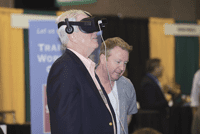Coming into Focus – Venture Created to Help Others Grasp Virtual Reality
Ed Zemba has quite a few memories from the huge trade show called VRLA, the world’s largest virtual and augmented reality expo, staged last spring, as the names suggests, in the City of Angels.
Most involve the technology itself and the large volumes of excitement generated about its seemingly limitless potential within the world of business. But he also can’t forget some of the comments directed his way when people found out his company, Robert Charles Photography, was based 3,000 miles to the east.
“One guy said ‘hey, you’re two years early,’ or something to that effect,’” said Zemba, who explained that this commentator was noting that the Northeast usually lags well behind the west coast when it comes to technological breakthroughs of this kind, and was adding some pointed sarcasm and exaggeration (maybe) to the equation.
Zemba was somewhat taken aback by this, and said that such comments were repeated enough that he actually developed and refined a comeback of sorts.
“I said, ‘we do OK back east — wasn’t most of this technology developed at MIT?’” he recalled, adding that those who heard the line were mostly unimpressed and had a comeback of their own.
“One guy said ‘yeah, OK, but what do the guys at MIT do when they develop the technology? They come out here to the West Coast, that’s what they do.’ They were tough,’” he recalled, adding that this back and forth, coupled with the tremendously powerful displays of what VR and AR can do — and in some cases, are already doing — inspired him.
To be more specific, the experiences inspired him to do what he could to make sure that, when it came to virtual reality and augmented reality, businesses in the 413 area code and beyond were not late (or much later) to the party when it comes to these technologies, as they are with so many other forms of innovation.
To that end, he partnered with several other business owners in the region to create a venture called Link to VR, a name that pretty much says it all. Indeed, the company was created to help companies understand the vast potential of this technology — for everything from helping patients understand a medical procedure by transporting themselves (virtually, of course) into an organ or joint so they can see what’s wrong and what the doctor will do to fix it, to dramatically reducing the costs of training programs by curtailing or eliminating the need to travel — and then create a plan to put it to use.
“The earlier we can collectively get our heads around this, the better off we’re going to be,” he explained, using ‘we’ to mean business owners, but also educators, parents, and other constituencies. “We want to help people transition to the next platform and incorporate this technology into their business model.”
And a specific focal point for the team at Link to VR is the region’s large and diverse healthcare sector, where the applications for this technology are many, and seemingly limitless, said Zemba.
Indeed, he listed everything from training those seeking careers in healthcare to the use of VR to provide pain-management solutions for children’s hospitals as potential, and, in some cases, already existing uses for the technology.
“Healthcare is an area where we see enormous opportunity for this technology,” he said, “as a learning tool, a teaching tool, and a way for people to grow their businesses and take them to new levels.”
And this brings us to the Western Mass. Business Expo, staged Nov. 3 at the MassMutual Center. In many ways, it was a coming-out party of sorts for VR and AR, and that was the plan.
Zemba, a huge supporter of the show going back to the ’90s, wanted this year’s event to become a vehicle for introducing the technology and putting its full potential on display.
To that end, he worked with BusinessWest, producer of the Expo, to create a wide range of programming that not only allowed attendees to be wowed by what they see when they put the goggles on (although that is a big part of it), but to enable them to fully understand how it can be applied to their business and, also, how to get the ball rolling.
“I can remember that the business show was always a time to learn about new technology and new ways of doing business,” he explained. “That’s why this was the perfect forum for putting this technology on display and helping business owners get both hands around it.”
Learning — and doing — opportunities came in several flavors, from so-called ‘experience rooms,’ where Expo attendees tried out the Oculus Touch Technology to see where this technology can take them (figuratively, but also from a business perspective) to an educational seminar called “Enterprise Virtual Reality: From Concept to Reality.”
In the experience rooms, attendees could use the technology for everything from a detailed look at the human body —broken down into its various systems — to a detailed tour of the Coliseum in Rome, where they could virtually sit in some of the seats.
Meanwhile, the seminar, led by Rik Shorten, chief creative officer for California-based BioFlightVR, one of the leading-edge companies bringing VR to light, delved deeper into the business applications of the technology.
Shorten, an Emmy winner for his work on CSI and a special-effects veteran who has been involved with a number of shows, talked about the technology and its potential in everything from sports to education; the automotive industry to publishing; architecture to the arts.
“You can cross the Delaware with George Washington, or go back to Kitty Hawk on the day the Wright brothers took their historic first flight, and not only see it, but hear the engine and walk near the plane,” he explained, listing only a few of the myriad applications of the technology in education and museum displays. “We’re just scratching the surface when it comes to what VR and AR can do.”
But healthcare represented the biggest slice on the pie chart he presented showing potential uses of VR and AR technology, he went on, adding that its potential in training and other applications is enormous.
And all this helps explain why there is a need to get out front on this technology.
Indeed, Zemba, like others who have come to know and appreciate VR and AR, refers to this as “disruptive technology.”
That’s a technical term, and a business term, one that has come to define technology that displaces an existing technology and shakes up an industry — or several of them. Recent examples include the PC, cell phones, and e-mail. Others, from past decades, include the telephone, television, and jet travel.
Zemba knows a little about disruptive technology, because he’s seen it, from a business perspective, up close.
Indeed, digital photography certainly fits that description, he explained, adding that, when the technology exploded onto the scene in the ’90s, some could see what it was going to do, reacted, and took full advantage of it. Others, including established corporations like Polaroid, were late to react or didn’t react at all, and paid a very steep price for their hesitation and arrogance.
“I saw some companies increase their sales exponentially, and I saw other companies go out of business,” he explained. “And what determined which direction you took was how you embraced the technology and how you prepared for it.”
The same will likely be true in many respects when it comes to virtual reality, he said, adding that it has vast potential to impact virtually every form of business, and especially healthcare and education.
“When I first saw this technology in use, I thought it was science fiction; I said, ‘we cannot be on that level yet,’” he recalled. “But it’s not science fiction. It’s real, and in many respects, it’s here.”
But not many people in business know that, or understand what it all means, he went on, adding that three area businesses — Robert Charles, Del Padre Digital, and Tiger Web Designs, all in East Longmeadow — have come together to, as the name connotes, link businesses to VR.
“Most businesses have no real idea that this technology exists, or how to use it,” he noted, adding that this new venture was created specifically to do something about that.
And by link, Zemba means educating them about the technology and its practical applications, but also linking them with resources and potential partners, like BioflightVR.
The programs at the Expo, as well as a separate event at TechSpring in Springfield involving businesses in the healthcare sector, were designed to enable attendees to grasp the technology, in every sense of that verb, said Zemba.
And such work will go on, he said, because the East Coast cannot, as those attendees at the California trade implied, be late to the party with this technology.


